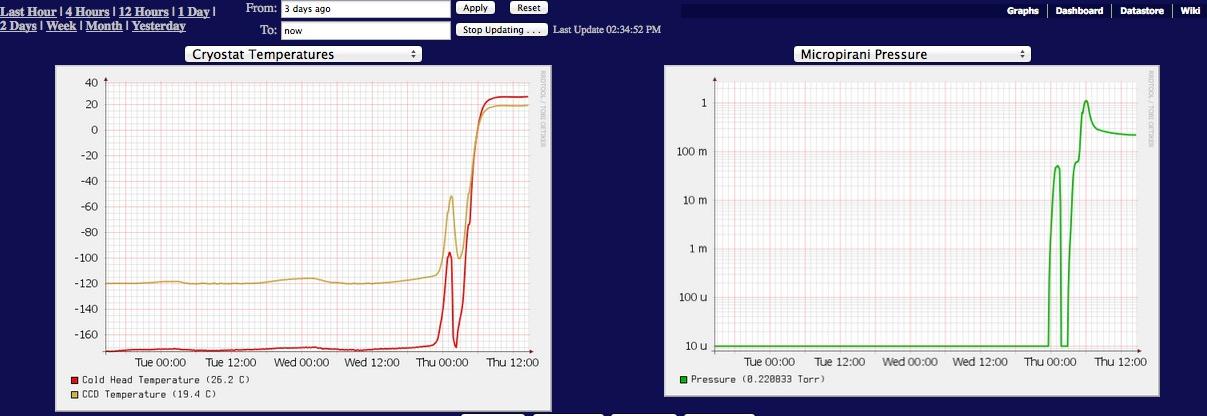
Before the repairs to the HDI dewar, the pressure rose steadily over time, requiring that the camera be removed from the telescope and pumped down about once a month.

Peter Onaka and his team came to Kitt Peak to make repairs to the system in November, 2014. Since that time, the camera has been much more stable. In fact, it has not been necessary to pump the dewar once since the repair.

Note the anticorrelation between ambient temperature and pressure in the CCD dewar. Below is a graph showing measurements over the past week. On the left is a graph of temperature: it dips during the night, between UT 3:00 - 12:00. On the right is a graph of pressure inside the dewar, in micro-torr. The peaks appear at night, when the temperature is lowest.

This same relationship between ambient temperature and pressure can be seen on a longer timescale. The graph below shows pressure over the past seven months. The periods when the pressure is below 10 micro-torr correspond to times when the WIYN 0.9-m telescope was not being used -- and to times near full moon.

I do not understand this correlation of higher pressure readings inside the dewar with lower ambient temperature readings.
Every image taken with HDI so far, starting in Feb, 2013, is still available from the datastore computer. One can access the data via the standard web interface:
http://hdiserver.kpno.noao.edu/ds/hdi/
There have been (as of May 26, 2015) a total of 58,680 images taken by HDI. The count by month is shown below.
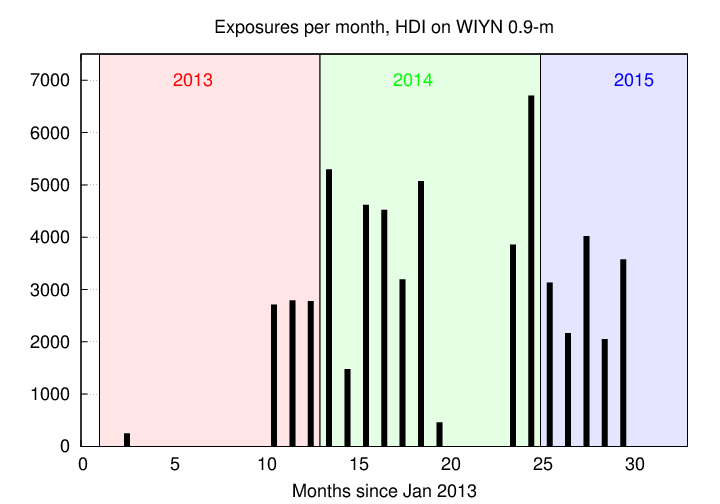
The volume of those images is
(58,680 image) * (35.5 MByte per image) =~ 2,080,000 MByte
= 2,080 GByte
= 2.08 GByte
I don't know the size of the disk storage on the datastore computer. According to Exhibit1_HDI_Contract, it should be "a minimum capacity of 2 Terabytes" available under RAID5, while according to Exhibit4_HDI_Contract, it is "approx. 4 TB, hot swappable".
Neither I nor ordinary users can access the datastore computer directly, which is why I don't know exactly how big the disk is, nor how much space is left.
However, it is likely that with 2 TB of data taken, and likely about 2 TB of storage space, the system may start to write over the earliest images; it is set up to act as a circular buffer. Of course, images have (for the most part) been saved into the NOAO "Save-the-bits" archive each night.
If we wish to make our own backup of every HDI image ever taken, we ought to do so very soon, perhaps during the summer shutdown of 2015.
Users of the WIYN 0.9-m telescope are asked to fill out a web page at the end of each night, describing the duration of the night, the fraction of time spent in various categories, the seeing, and a few other items. I collected the logs written between Nov 2013 and May 2015. Below are simple summaries of the information contained in these logs.
The number of nights used during each month has recently averaged about 15:
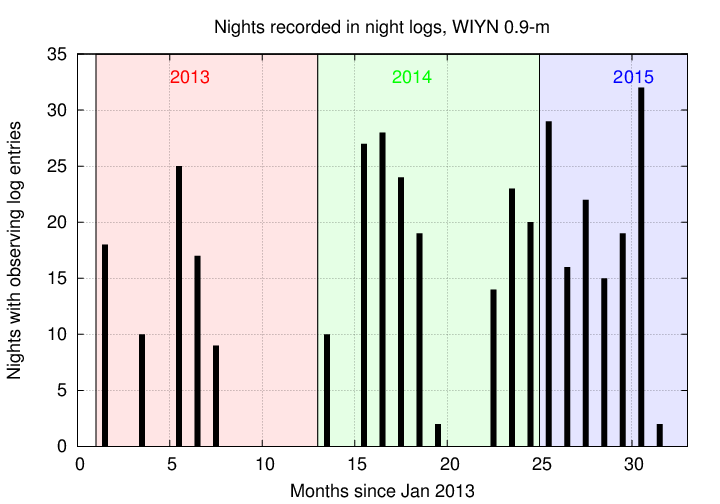
How have we used the time during each night? Observers are asked to record the number of hours between sunset and sunrise, and the number of hours spent doing various operations. Roughly two-thirds of the scheduled time each month is spent doing science; in other words, about one-third of the scheduled time is lost to bad weather or (much less commonly) technical problems.
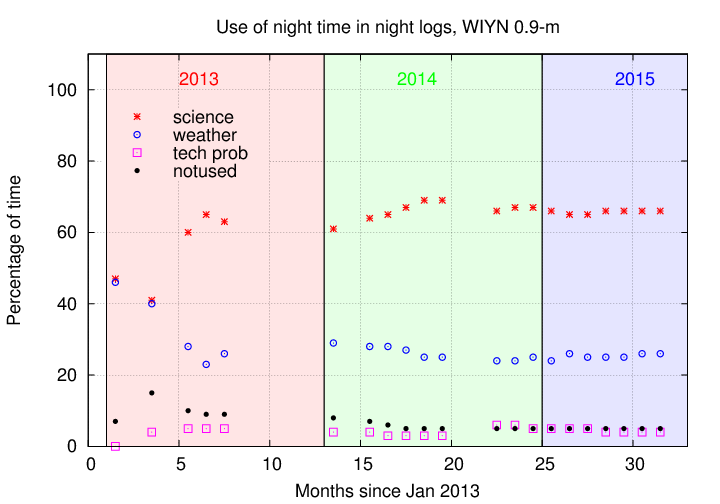
The "seeing" is a rather vague term, and its definition may vary slightly from one user to the next. One might assume that it is related to the FWHM of a stellar image. I took all the values reported by users during each month, and computed the quartile values. The graph below shows the median seeing in arcseconds (symbol) with errorbars running up to the 75th and down to the 25th quartile. The typical value appears to lie between 1.5 and 2.0 arcseconds.
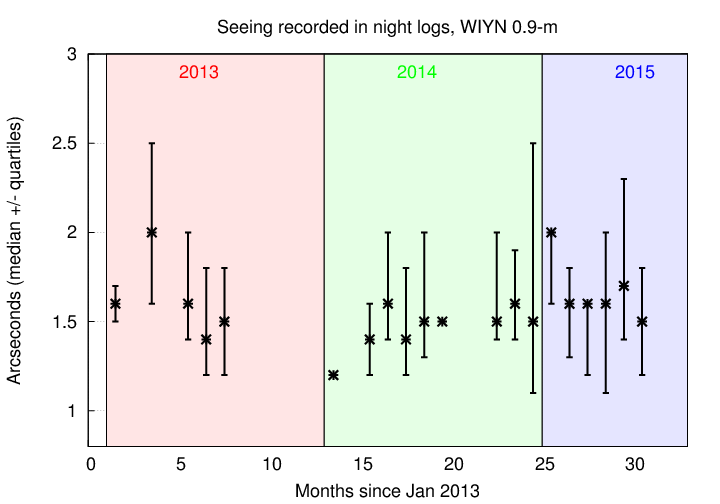
I received E-mail yesterday from Jim Winsky, one of the WIYN 0.9-m support staff at Kitt Peak. His message indicates that it has become necessary for us to replace the special fluid which is used in the cooling system for HDI.
I assist Flynn at the 0.9 meter. There are a lot of emails below, but the bottom line is that it looks like the HDI camera system needs a recharge of the PT16 gas at the 0.9 meter. Peter Onaka (HDI design lead in Hawaii) referred to a white shipping container that has the hardware and plumbing and some PT16 gas bottles that are needed for the recharge, all of which I have located here. Would you have some time tomorrow (Thursday) to help with the recharge? If you can help me set it up, I can watch it and take over from there. Peter also mentioned that it would be a good idea to pump down the system at the same time, since there has likely been outgassing since I turned the camera compressor OFF about an hour ago. It will be at room temp. very soon (and tomorrow when we start). We appreciate your help. I'll try to be at the 0.9 meter by mid morning ~9:00 AM tomorrow.
The camera is currently warm, the cooling system has been turned off, and the dewar is at atmospheric pressure. Jim Winsky and Charles Corson will be replacing the fluid later today or tomorrow (or next week) with materials we have on-site.
The problem MAY be a simple loss of fluid due to a slow leak, but it could also be
The rise in pressure was relatively quick.
